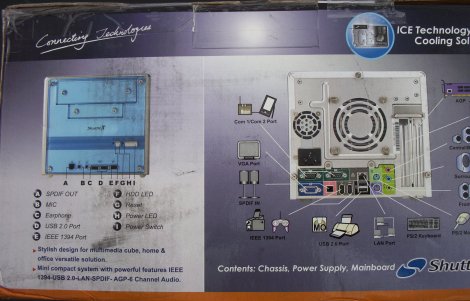What is it?


The box should give you some insight into exactly what it is. Even at this juncture, it looks like a mini hi-fi. Essentially, it's a miniaturised PC chassis (case), complete with in-built PSU and motherboard with appropriate cooler, hence the bare-bones title. Naturally, a smaller chassis demands a bespoke motherboard.
The SS51G is different in the fact that it supports Pentium 4 CPUs operating on a 533FSB, we've previously seen Shuttle bare-bones models for the P3 and Athlon respectively. Let's have a look inside. There are plenty of goodies in this small package.

The unit measures a scant 20cm in width, 18cm in height and 28cm deep. That should give you a pretty good idea of just how small it is. The front panel houses the main power and reset buttons. When in operation, a pleasing blue LED glows next to the power switch.
With something as small as this, overall design and ergonomics become vitally important. The front houses a 5.25" bay for a CD-based drive, a 3.5" bay for either a floppy drive or space for another hard drive. The interesting features lie at the bottom of the above picture.
Going from left-to-right, we have a S/PDIF out socket, a microphone socket followed by an earphone socket. Next door, the two USB ports are USB2.0 compliant. Lastly, a Firewire (IEEE1394a) port completes the lineup, giving you options for high-speed peripheral connectivity.

To keep weight to a bare minimum, Shuttle have chosen to outfit the SS51G with an aluminium body and blue acrylic front cover. Not only does it look good, the case, motherboard, PSU and cooler come in at less than 3KG. The rear of the SS51 houses the other extras.

The lower panel groups together some of the more usual ports found on our PCs. Starting from left-to-right again, we have the standard COM port sitting above a VGA connector powered by the on-board SiS315 chip. Next, the second COM port sits above the S/PDIF in and another two Firewire ports, making three in total. These are followed by another two USB2.0 ports and a LAN / RJ45 port for networking. You'll recognise the standard PS/2 ports next. Lastly, we have the ubiquitous on-board sound ports. A lot is going on here.
The SS51G's diminutive size precludes the inclusion of more than one PCI slot. We do have an AGP slot, however. You can see that a great deal has been engineered into this chassis.
Let's now have a look inside.









